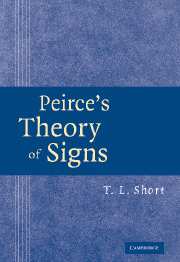Book contents
- Frontmatter
- Contents
- Preface
- Acknowledgments
- 1 Antecedents and Alternatives
- 2 The Development of Peirce's Semeiotic
- 3 Phaneroscopy
- 4 A Preface to Final Causation
- 5 Final Causation
- 6 Significance
- 7 Objects and Interpretants
- 8 A Taxonomy of Signs
- 9 More Taxa
- 10 How Symbols Grow
- 11 Semeiosis and the Mental
- 12 The Structure of Objectivity
- Bibliography
- Name Index
- Subject Index
- Frontmatter
- Contents
- Preface
- Acknowledgments
- 1 Antecedents and Alternatives
- 2 The Development of Peirce's Semeiotic
- 3 Phaneroscopy
- 4 A Preface to Final Causation
- 5 Final Causation
- 6 Significance
- 7 Objects and Interpretants
- 8 A Taxonomy of Signs
- 9 More Taxa
- 10 How Symbols Grow
- 11 Semeiosis and the Mental
- 12 The Structure of Objectivity
- Bibliography
- Name Index
- Subject Index
Summary
Let us now examine the principles implicit in Peirce's semeiotic taxonomy and then proceed to his later system of ten trichotomies and sixty-six classes of sign. That, anyway, is what we should like to do; but the principles are made less certain, not more, by the later taxonomy, in which unresolved problems proliferate. The promise of a system, rigorous and comprehensive, remains a promise only.
Principles of Semeiotic Taxonomy
Certain principles should be evident from the preceding chapter. They are that the system of classification is to be based on the general analysis of signhood as consisting in an irreducibly triadic relation, of sign, object, and interpretant; that each aspect of this relation is divisible trichotomically according to the three phaneroscopic categories; that each sign must be of one or another division of each trichotomy; and that no sign may be of more than one division of any trichotomy. These principles do not explain why certain inter-trichotomic combinations, such as indexical qualisigns or argumentative icons, are impossible. But the forbidden combinations exceed in number those permitted, and those permitted fall into a neat pattern that is the most salient feature of Peirce's semeiotic taxonomy. Consider the facts about the three trichotomies with which we are already acquainted.
A symbol signifies by a law that relates instances of one type (the symbol) to another type or to its instances. But a type is a 3rd. Now, legisigns alone are 3rds; for sinsigns are 2nds and qualisigns are 1sts.
- Type
- Chapter
- Information
- Peirce's Theory of Signs , pp. 235 - 262Publisher: Cambridge University PressPrint publication year: 2007



